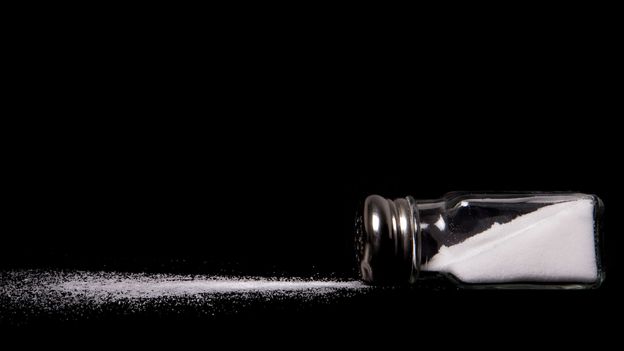Updated by: David C. Dugdale, III, MD, Professor of Medicine, Division of General Medicine, Department of Medicine, University of Washington School of Medicine. Also reviewed by David Zieve, MD, MHA, Medical Director, Brenda Conaway, Editorial Director, and the A.D.A.M. Editorial team.
Review Date 10/13/2018
DASH stands for Dietary Approaches to Stop Hypertension. The DASH diet can help lower high blood pressure and cholesterol and other fats in your blood. It can help lower your risk for heart attack and stroke and help you lose weight. This diet is low in sodium (salt) and rich in nutrients.
How DASH Works
The DASH diet reduces high blood pressure by lowering the amount of sodium in your diet to 2300 milligrams (mg) a day. Lowering sodium to 1500 mg a day reduces blood pressure even more. It also includes a variety of foods rich in nutrients that help some people lower blood pressure, such as potassium, calcium, and magnesium.
On the DASH diet, you will:
- Get plenty of vegetables, fruits, and fat-free or low-fat dairy
- Include whole grains, beans, seeds, nuts, and vegetable oils
- Eat lean meats, poultry, and fish
- Cut back on salt, red meat, sweets, and sugary drinks
- Limit alcoholic beverages
You should also get at least 30 minutes of moderate-intensity exercise most days of the week. Examples include brisk walking or riding a bike. Aim to get at least 2 hours and 30 minutes of exercise per week.
You can follow the DASH diet if you want to prevent high blood pressure. It can also help you lose extra weight. Most people can benefit from lowering sodium intake to 2300 milligrams (mg) a day.
Your health care provider may suggest cutting back to 1500 mg a day if you:
- Already have high blood pressure
- Have diabetes or chronic kidney disease
- Are African American
- Are age 51 or older
If you take medicine to treat high blood pressure, do not stop taking your medicine while on the DASH diet. Be sure to tell your provider you are following the DASH diet.
How to get Started
On the DASH diet, you can eat foods from all food groups. But you will include more of the foods that are naturally low in salt, cholesterol, and saturated fats. You will also include foods that are high in potassium, calcium, magnesium, and fiber.
Here's a list of the food groups and how many servings of each you should have per day. For a diet that has 2000 calories per day, you should eat:
- Vegetables (4 to 5 servings a day)
- Fruits (4 to 5 servings a day)
- Low-fat or fat-free dairy products, such as milk and yogurt (2 to 3 servings a day)
- Grains (6 to 8 servings a day, and 3 should be whole grains)
- Fish, lean meats, and poultry (2 servings or less a day)
- Beans, seeds, and nuts (4 to 5 servings a week)
- Fats and oils (2 to 3 servings a day)
- Sweets or added sugars, such as jelly, hard candy, maple syrup, sorbet, and sugar (fewer than 5 servings a week)
The number of servings you have each day depends on how many calories you need.
- If you're trying to lose weight, you may need fewer servings than listed.
- If you are not very active, aim for the lower number of servings listed.
- If you are moderately active, have the higher number of servings.
- If you are very active, you may need more servings than listed.
Your provider can help find the right number of servings a day for you.
Know your Serving Sizes
To know how much to eat, you need to know serving sizes. Below are sample servings for each food group.
Vegetables:
- 1 cup (70 grams) raw leafy vegetables
- ½ cup (90 grams) chopped raw or cooked vegetables
Fruits:
- 1 medium fruit (6 ounces or 168 grams)
- ½ cup (70 grams) fresh, frozen, or canned fruit
- ¼ cup (25 grams) dried fruit
Fat-free or low-fat dairy products:
- 1 cup (240 milliliters) milk or yogurt
- 1½ ounce (oz) or 50 grams (g) cheese
Grains (Aim to make all of your grain choices whole grain. Whole grain products contain more fiber and protein than "refined" grain products.):
- 1 slice bread
- ½ cup (80 grams) cooked rice, pasta, or cereal
Lean meats, poultry, and fish:
- 3 oz (85 g) of cooked fish, lean meat, or poultry
Nuts, seeds, and legumes:
- ½ cup (90 grams) cooked legumes (dried beans, peas)
- 1/3 cup (45 grams) nuts
- 1 tablespoon (10 grams) seeds
Fats and oils:
- 1 teaspoon (5 milliliters) vegetable oil
- 2 tablespoons (30 grams) low-fat salad dressing
- 1 teaspoon (5 grams) soft margarine
Sweets and added sugars:
- 1 tablespoon (15 grams) sugar
- 1 tablespoon (15 grams) jelly or jam
- ½ cup (70 grams) sorbet, gelatin dessert
Tips for Following DASH
It's easy to follow the DASH diet. But it might mean making some changes to how you currently eat. To get started:
- DO NOT try to make changes all at once. It's fine to change your eating habits gradually.
- To add vegetables to your diet, try having a salad at lunch. Or, add cucumber, lettuce, shredded carrots, or tomatoes to your sandwiches.
- There should always be something green on your plate. It's fine to use frozen vegetables instead of fresh. Just make sure the package does not contain added salt or fat.
- Add sliced fruit to your cereal or oatmeal for breakfast.
- For dessert, choose fresh fruit or low-fat frozen yogurt instead of high-calorie sweets, such as cakes or pies.
- Choose healthy snacks, such as unsalted rice cakes or popcorn, raw vegetables, or yogurt. Dried fruits, seeds, and nuts also make great snack choices. Just keep these portions small because these foods are high in total calories.
- Think of meat as part of your meal, instead of the main course. Limit your servings of lean meat to 6 ounces (170 grams) a day. You can have two 3-ounce (85 grams) servings during the day.
- Try cooking without meat at least twice each week. Instead, eat beans, nuts, tofu, or eggs for your protein.
Tips to Lower Your Salt
To lower the amount of salt in your diet:
- Take the salt shaker off the table.
- Flavor your food with herbs and spices instead of salt. Lemon, lime, and vinegar also add flavor.
- Avoid canned foods and frozen entrees. They are often high in salt. When you make things from scratch you have more control over how much salt goes in them.
- Check all food labels for sodium. You may be surprised at how much you find, and where you find it. Frozen dinners, soups, salad dressings, and prepared foods often have a lot of sodium.
- Choose foods that contain less than 5% for the daily value of sodium.
- Look for low-sodium versions of foods when you can find them.
- Limit foods and condiments that have a lot of salt, such as pickles, olives, cured meats, ketchup, soy sauce, mustard, and barbeque sauce.
- When dining out, ask that your food be made with no added salt or MSG.
Where to get More Information
There are many books about the DASH diet plan to help you get started. These books can also provide sample meal plans and recipe ideas.








/112219_carbs_lead-2000-1dc94a7ae35d48fcad01527409988ccc.jpg)


